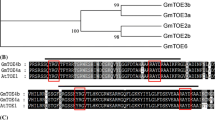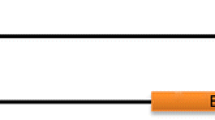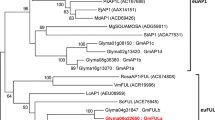Abstract
Soybean [Glycine max (L.) Merr.] is an important crop used for human consumption, animal feed and biodiesel fuel. Wering time and maturity significantly affect soybean grain yield. In Arabidopsis thaliana, miR156 has been proposed to regulate the transition from the juvenile to the adult phase of shoot development, which is accompanied by changes in vegetative morphology and an increase in reproductive potential. However, the molecular mechanisms underlying miR156 function in soybean flowering remain unknown. Here, we report that the overexpression of GmmiR156b delays flowering time in soybean. GmmiR156b may target SPL orthologs and negatively regulate GmSPLs, thereby delaying flowering in soybean under LD and natural conditions. GmmiR156b down-regulates several known flowering time regulators in soybean, such as GmAP1 (a, b, c), GmLFY2, GmLFY2, GmFULs, GmSOC1s, GmFT5a, and GmmiR172. These data show that a similar miR156-SPL regulatory module was conserved in the soybean flowering pathway. However, GmFULs, GmSOC1a and GmSOC1b were significantly suppressed under LD conditions but not under SD conditions, which is different in Arabidopsis that these genes were down-regulated irrespective of photoperiod. In addition, GmmiR156b was up-regulated by E1, E2 (GmGI), E3 and E4, which control flowering time and maturity in soybean, and suppressed E1 (E1-Like) and E2 (E2-Like) genes under LD conditions. These data indicated that the miR156-SPL regulatory module was also with some degree of divergent in soybean flowering pathway.







Similar content being viewed by others
References
Abe J, Xu DH, Miyano A, Komatsu K, Kanazawa A, Shimamoto Y (2003) Photoperiod-insensitive Japanese soybean landraces differ at two maturity loci. Crop Sci 43:1300–1304
Aung B, Gruber MY, Amyot L, Omari K, Bertrand A, Hannoufa A (2014) MicroRNA156 as a promising tool for alfalfa improvement. Plant Biotechnol J. doi:10.1111/pbi.12308
Bernard RL (1971) Two major genes for time of flowering and maturity in soybeans. Crop Sci 11:242–244
Bhogale S, Mahajan AS, Natarajan B, Rajabhoj M, Thulasiram HV, Banerjee AK (2014) MicroRNA156: a potential graft-transmissible microRNA that modulates plant architecture and tuberization in Solanum tuberosum ssp. Andigena. Plant Physiol 164:1011–1027
Bonato ER, Vello NA (1999) E6, a dominant gene conditioning early flowering and maturity in soybeans. Genet Mol Biol 22:229–232
Buzzell RI (1971) Inheritance of a soybean flowering response to fluorescent-daylength conditions. Can J Genet Cytol 13:703–707
Buzzell R, Voldeng H (1980) Inheritance of insensitivity to long daylength. Soyb Genet Newsl 7:26–29
Chi Y, Huang F, Liu H, Yang S, Yu D (2011) An APETALA1-like gene of soybean regulates flowering time and specifies floral organs. J Plant Physiol 168:2251–2259
Cober ER, Voldeng HD (2001) A new soybean maturity and photoperiod-sensitivity locus linked to E1 and T. Crop Sci 41:698–701
Cober ER, Tanner JW, Voldeng HD (1996) Soybean photoperiod-sensitivity loci respond differentially to light quality. Crop Sci 36:606–610
Cober ER, Molnar SJ, Charette M, Voldeng HD (2010) A new locus for early maturity in soybean. Crop Sci 50:524–527
Fehr WR, Caviness CE, Burmood DT, Pennington JS (1971) Stage of development descriptions for soybeans, Glycine max (L.) Merrill. Crop Sci 11:929–931
Ferrandiz C, Gu Q, Martienssen R, Yanofsky MF (2000) Redundant regulation of meristem identity and plant architecture by FRUITFULL, APETALA1 and CAULIFLOWER. Development 127:725–734
Flores T, Karpova O, Su X, Zeng P, Bilyeu K, Sleper DA, Nguyen HT, Zhang ZJ (2008) Silencing of GmFAD3 gene by siRNA leads to low α-linolenic acids (18:3) of fad3-mutant phenotype in soybean [Glycine max (Merr.)]. Transgenic Res 17:839–850
Fornara F, Coupland G (2009) Plant phase transitions make a SPLash. Cell 138:625–627
Fu C, Sunkar R, Zhou C, Shen H, Zhang JY, Matts J, Wolf J, Mann DG, Stewart CN Jr, Tang Y, Wang ZY (2012) Overexpression of miR156 in switchgrass (Panicum virgatum L.) results in various morphological alterations and leads to improved biomass production. Plant Biotechnol J 10:443–452
Kim JJ, Lee JH, Kim W, Jung HS, Huijser P, Ahn JH (2012) The microRNA156-SQUAMOSA PROMOTER BINDING PROTEIN-LIKE3 module regulates ambient temperature-responsive flowering via FLOWERING LOCUS T in Arabidopsis. Plant Physiol 159:461–478
Kong F, Liu B, Xia Z, Sato S, Kim BM, Watanabe S, Yamada T, Tabata S, Kanazawa A, Harada K et al (2010) Two coordinately regulated homologs of FLOWERING LOCUS T are involved in the control of photoperiodic flowering in soybean. Plant Physiol 154:1220–1231
Kong F, Nan H, Cao D, Li Y, Wu F, Wang J, Lu S, Yuan X, Cober ER, Abe J, Liu B (2014) A new dominant gene E9 conditions early flowering and maturity in soybean. Crop Sci. doi:10.2135/cropsci2014.03.0228
Koseki M, Goto K, Masuta C, Kanazawa A (2005) The star-type color pattern in Petunia hybrida ‘Red star’ flowers is induced by sequence-specific degradation of chalcone synthase RNA. Plant Cell Physiol 46:1879–1883
Liu B, Kanazawa A, Matsumura H, Takahashi R, Harada K, Abe J (2008) Genetic redundancy in Soybean photoresponses associated with duplication of the Phytochrome A gene. Genetics 180:995–1007
McBlain B, Bernard R (1987) A new gene affecting the time of flowering and maturity in soybeans. J Hered 78:160–162
Meng Q, Zhang C, Huang F, Gai J, Yu D (2007) Molecular cloning and characterization of a LEAFY-like gene highly expressed in developing soybean seeds. Seed Sci Res 17:297–302
Na X, Jian B, Yao W, Wu C, Hou W, Jiang B, Bi Y, Han T (2013) Cloning and functional analysis of the flowering gene GmSOC1-like, a putative SUPPRESSOR OF OVEREXPRESSION CO1/AGAMOUS-LIKE 20 (SOC1/AGL20) ortholog in soybean. Plant Cell Rep 32:1219–1229
Nan H, Cao D, Zhang D, Li Y, Lu S, Tang L, Yuan X, Liu B, Kong F (2014) GmFT2a and GmFT5a redundantly and differentially regulate flowering through interaction with and upregulation of the bZIP transcription factor GmFDL19 in soybean. PLoS ONE 9:e97669
Ray JD, Hinson K, Mankono JEB, Malo MF (1995) Genetic-control of a long-juvenile trait in soybean. Crop Sci 35:1001–1006
Schwab R, Palatnik JF, Riester M, Schommer C, Schmid M, Weigel D (2005) Specific effects of microRNAs on the plant transcriptome. Dev Cell 8:517–527
Song Q, Liu Y, Hu X, Zhang W, Ma B, Chen S, Zhang J (2011) Identification of miRNAs and their target genes in developing soybean seeds by deep sequencing. BMC Plant Biol 11:5
Sun H, Jia Z, Cao D, Jiang B, Wu C, Hou W, Liu Y, Fei Z, Zhao D, Han T (2011) GmFT2a, a soybean homolog of FLOWERING LOCUS T, is involved in flowering transition and maintenance. PLoS ONE 6(12):e29238
Thakare D, Kumudini S, Dinkins RD (2011) The alleles at the E1 locus impact the expression pattern of two soybean FT-like genes shown to induce flowering in Arabidopsis. Planta 234:933–943
Wang J, Czech B, Weigel D (2009) miR156-regulated SPL transcription factors define an endogenous flowering pathway in Arabidopsis thaliana. Cell 138:738–749
Watanabe S, Hideshima R, Xia Z, Tsubokura Y, Sato S, Nakamoto Y, Yamanaka N, Takahashi R, Ishimoto M, Anai T et al (2009) Map-based cloning of the gene associated with the soybean maturity locus E3. Genetics 182:1251–1262
Watanabe S, Xia Z, Hideshima R, Tsubokura Y, Sato S, Yamanaka N, Takahashi R, Anai T, Tabata S, Kitamura K et al (2011) A map-based cloning strategy employing a residual heterozygous line reveals that the GIGANTEA gene is involved in soybean maturity and flowering. Genetics 188:395-U260
Wei S, Yu B, Gruber MY, Khachatourians GG, Hegedus DD, Hannoufa A (2010) Enhanced seed carotenoid levels and branching in transgenic Brassica napus expressing the Arabidopsis miR156b gene. J Agric Food Chem 58:9572–9578
Willems E, Leyns L, Vandesompele J (2008) Standardization of real-time PCR gene expression data from independent biological replicates. Anal Biochem 379:127–129. doi:10.1016/j.ab.2008.04.03
Wu G, Poethig RS (2006) Temporal regulation of shoot development in Arabidopsis thaliana by miR156 and its target SPL3. Development 133:3539–3547
Wu G, Park MY, Conway SR, Wang J, Weigel D, Poethig RS (2009) The sequential action of miR156 and miR172 regulates developmental timing in Arabidopsis. Cell 138:750–759
Xia Z, Watanabe S, Yamada T, Tsubokura Y, Nakashima H, Zhai H, Anai T, Sato S, Yamazaki T, Lu S et al (2012) Positional cloning and characterization reveal the molecular basis for soybean maturity locus E1 that regulates photoperiodic flowering. Proc Natl Acad Sci USA 109:E2155–E2164
Xie K, Wu C, Xiong L (2006) Genomic organization, differential expression, and interaction of SQUAMOSA PROMOTER-BINDING-LIKE transcription factors and microRNA156 in rice. Plant Physiol 142:280–293
Xing S, Salinas M, Hohmann S, Berndtgen R, Huijser P (2010) miR156-targeted and nontargeted SBP-box transcription factors act in concert to secure male fertility in Arabidopsis. Plant Cell 22:3935–3950
Xu F, Liu Q, Chen L, Kuang J, Walk T, Wang J, Liao H (2013a) Genome-wide identification of soybean microRNAs and their targets reveals their organ-specificity and responses to phosphate starvation. BMC Genom 14(1):66
Xu M, Xu Z, Liu B, Kong F, Tsubokura Y, Watanabe S, Xia Z, Harada K, Kanazawa A, Yamada T et al (2013b) Genetic variation in four maturity genes affects photoperiod insensitivity and PHYA-regulated post-flowering responses of soybean. BMC Plant Biol 13(1):91
Yamaguchi A, Wu MF, Yang L, Wu G, Poethig RS, Wagner D (2009) The microRNA-regulated SBP-box transcription factor SPL3 is a direct upstream activator of LEAFY, FRUITFULL, and APETALA1. Dev Cell 17:268–278
Yoshikawa T, Ozawa S, Sentoku N, Itoh JI, Nagato Y, Yokoi S (2013) Change of shoot architecture during juvenile-to-adult phase transition in soybean. Planta 238(1):229–237
Zhang B, Pan X, Stellwag EJ (2008) Identification of soybean microRNAs and their targets. Planta 229:161–182
Zhao X, Cao D, Huang Z, Wang J, Lu S, Xu Y, Liu B, Kong F, Yuan X (2015) Dual functions of GmTOE4a in the regulation of photoperiod-mediated flowering and plant morphology in soybean. Plant Mol Biol 88:343–355
Zhong X, Dai X, Xv J, Wu H, Liu B, Li H (2012) Cloning and expression analysis of GmGAL1, SOC1 homolog gene in soybean. Mol Biol Rep 39:6967–6974
Acknowledgments
We thank Dr. Kan Wang for providing the soybean transformation vector pTF101.1 and the Agrobacterium strain EHA101. This work was partially supported by the National Natural Science Foundation of China (31430065, 31071445, 31171579, 31201222, 31230050, 31371643 and 31571686); the Open Foundation of the Key Laboratory of Soybean Molecular Design Breeding, Chinese Academy of Sciences; the “Hundred Talents” Program of the Chinese Academy of Sciences; the Strategic Action Plan for Science and Technology Innovation of the Chinese Academy of Sciences (XDA08030108); the Heilongjiang Natural Science Foundation of China (ZD201001, JC201313); and the Research and Development of Applied Technology Project, Harbin (2014RFQYJ055).
Author information
Authors and Affiliations
Corresponding authors
Ethics declarations
Conflict of interest
The authors declare no conflict of interest.
Additional information
Dong Cao, Ying Li and Jialin Wang have contributed equally to this work.
Electronic supplementary material
Below is the link to the electronic supplementary material.
Rights and permissions
About this article
Cite this article
Cao, D., Li, Y., Wang, J. et al. GmmiR156b overexpression delays flowering time in soybean. Plant Mol Biol 89, 353–363 (2015). https://doi.org/10.1007/s11103-015-0371-5
Received:
Accepted:
Published:
Issue Date:
DOI: https://doi.org/10.1007/s11103-015-0371-5




